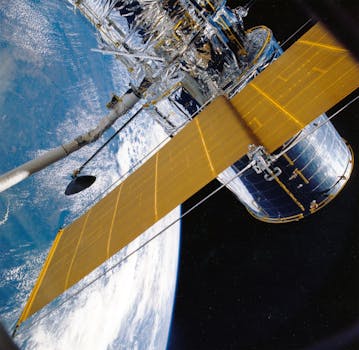
Orbiting Innovations: Key Updates in Satellite Telecommunications Technology
Orbiting innovations in satellite telecommunications technology have been on the rise in recent years, with numerous breakthroughs and advancements in the field. Satellite telecommunications technology refers to the use of satellites in orbit around the Earth to transmit and receive data, voice, and video communications. This technology has become an essential part of modern life, enabling global connectivity, navigation, and remote sensing.
Satellite telecommunications technology has undergone significant transformations since its inception, with the launch of the first commercial communications satellite, Intelsat 1, in 1965. Today, there are thousands of satellites in orbit, providing a wide range of services, including television broadcasting, mobile communications, internet connectivity, and navigation. The latest innovations in satellite telecommunications technology are focused on improving the efficiency, capacity, and reliability of satellite communications, as well as reducing costs and increasing accessibility.
Advancements in Satellite Design and Launch Technology
One of the key areas of innovation in satellite telecommunications technology is in the design and launch of satellites. Modern satellites are being built with advanced materials and technologies, such as 3D printing and modular design, which enable faster and more cost-effective production. Additionally, the development of reusable launch vehicles, such as SpaceX’s Falcon 9, has significantly reduced the cost of launching satellites into orbit. This has made it possible for more companies and organizations to launch their own satellites, increasing the number of satellites in orbit and expanding the range of services available.
Another area of innovation is in the use of small satellites, also known as CubeSats. These tiny satellites, which are typically smaller than a shoebox, are being used for a variety of applications, including Earth observation, communications, and scientific research. Small satellites are relatively inexpensive to build and launch, making them an attractive option for companies and organizations that want to establish a presence in space without breaking the bank.
Improvements in Satellite Communications Technology
Satellite communications technology has also undergone significant improvements in recent years, with the development of new technologies such as high-throughput satellites (HTS) and very high-throughput satellites (VHTS). These satellites use advanced technologies, such as phased arrays and beam-forming, to provide faster and more efficient communications services. HTS and VHTS satellites are being used to provide high-speed internet connectivity, as well as other communications services, such as video transmission and mobile connectivity.
Another area of innovation is in the use of advanced modulation techniques, such as quadrature amplitude modulation (QAM) and amplitude phase shift keying (APSK). These techniques enable satellites to transmit more data using the same amount of bandwidth, increasing the efficiency and capacity of satellite communications. Additionally, the development of new antenna technologies, such as active phased arrays and reflectarray antennas, has improved the performance and reliability of satellite communications systems.
Orbiting Innovations and the Future of Satellite Telecommunications
The latest orbiting innovations in satellite telecommunications technology are set to revolutionize the way we communicate and access information. With the development of new technologies, such as satellite constellations and mega-constellations, the possibilities are endless. Satellite constellations, which involve launching multiple satellites into orbit to provide global coverage, are being used to provide high-speed internet connectivity, as well as other communications services. Mega-constellations, which involve launching thousands of satellites into orbit, are being proposed to provide global connectivity and bridge the digital divide.
The future of satellite telecommunications technology is exciting and full of possibilities. With the continued innovation and advancement of satellite technology, we can expect to see new and exciting applications in the years to come. Whether it’s providing high-speed internet connectivity to remote communities or enabling global navigation and remote sensing, satellite telecommunications technology is set to play an increasingly important role in shaping our world.




